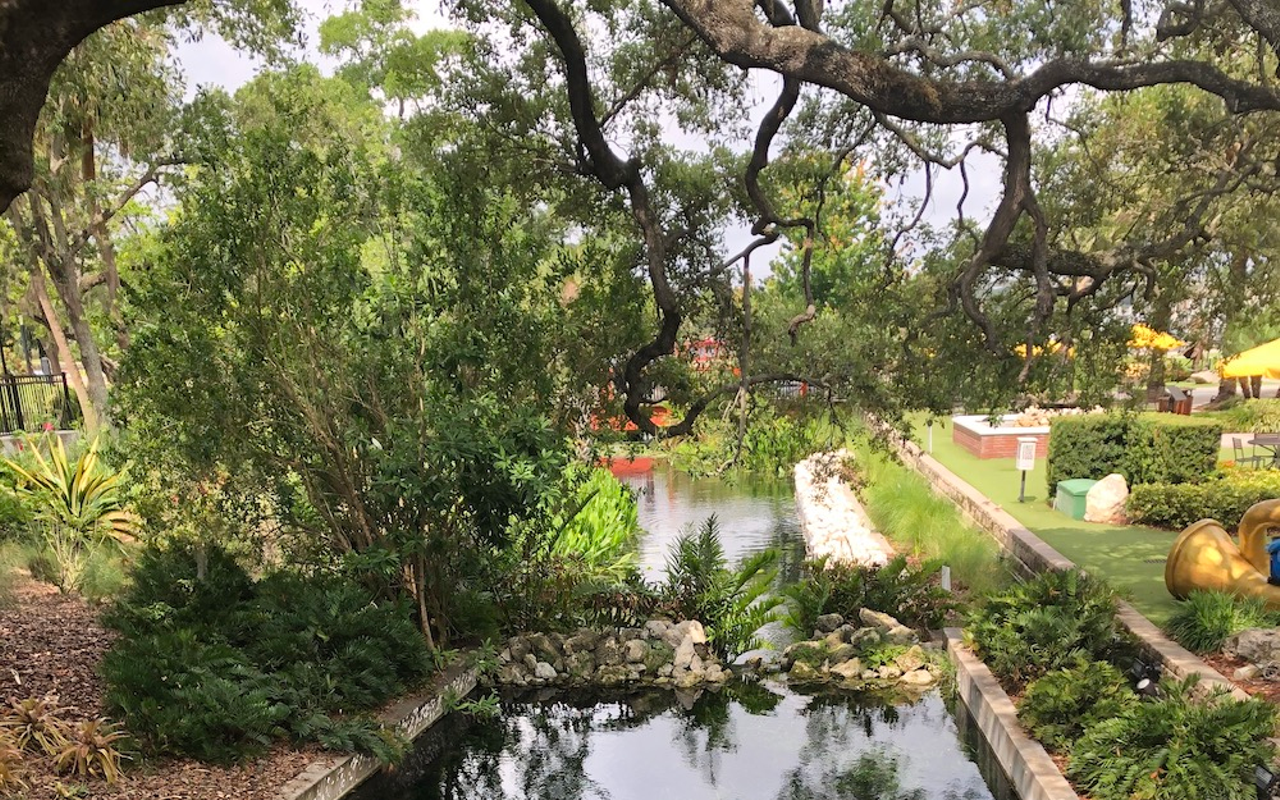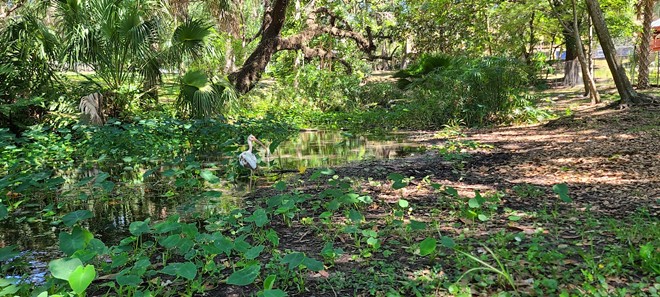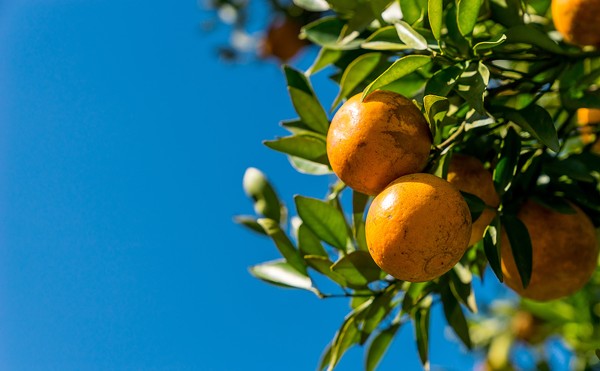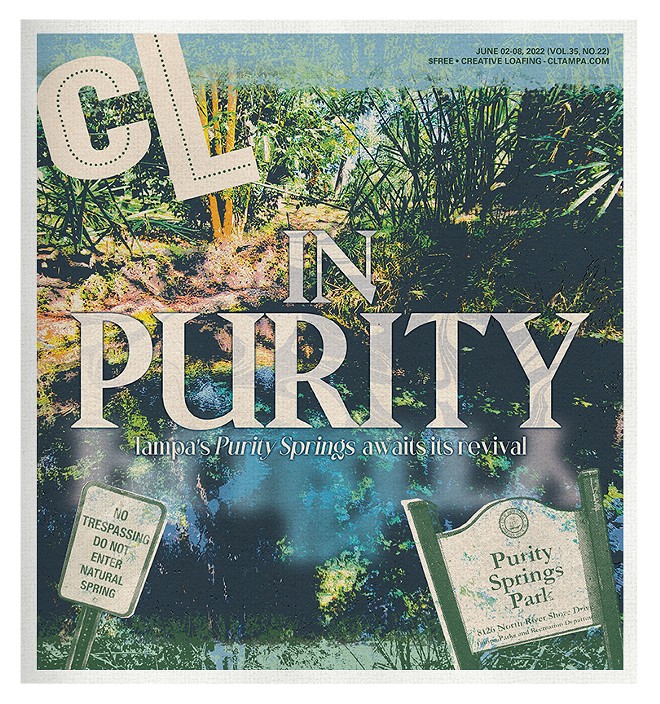
I'm feeling this breakdown down to my overheated core one sweltering Labor Day afternoon, cruising westward along Bird Street past River Tower Park. The park's sun-bleached fields stretch out on the left, while acres of strip malls and parking lots bake away on the right. Behind me, my five-year-old son is draped across his car seat like a steamed noodle. I've dragged the poor kiddo along on this adventure with promises that we'll "hunt for a hidden spring"—pretty enticing for a young explorer—but I estimate we're now four minutes short of a meltdown.
"We're super close," I tell him, not 100% sure about that, through the thrumming exhaust of a red light. "The river's right there by the tower, so the spring's got to be close."
We dart left and then right onto North River Shore Drive, grateful as the Hillsborough snakes into view and the trees throw cool shadows over the road. A moment later we're pulling off onto a graveled shoulder, unloading our picnic, and plunging into a small jungle of overgrown elephant ear and papyrus. We hug the edge of a dark pond shaded by the languid limbs of oaks. The curving path leads us back through the woods until suddenly a grassy slope falls away into a small, startlingly blue pool. It glows from within, like a jewel. It opens upward to the sky, like a wide-awake eye. My heart catches in my throat; the boy cheers. We finally found Purity Springs.
We aren't the only ones seeking this little blue wonder these days. Whit Remer, Sustainability and Resilience Officer for the City of Tampa, is leading an effort to restore Purity Springs, now backed by $217,000 from Tampa Bay Environmental Restoration Fund and the City of Tampa as well as a $1 million in American Rescue Plan money earmarked in the state budget. Remer himself discovered this little-known site as part of a "springs tour" led by University of South Florida School of Architecture and Community Design's Brian Cook, a landscape architect who researches the historic patterns of the Hillsborough River.
"When you see this little, blue, majestic spring nestled in the middle of an urban community," Remer reflects, "how do you not fall in love with it?"
My son is certainly falling for it. Distracted by laying out our picnic, I now notice his discarded shoes and socks. He heads for the cool water tumbling over the old concrete weir that holds back the blue basin."When you see this little, blue, majestic spring nestled in the middle of an urban community, how do you not fall in love with it?"
tweet this
"Hey!" I say, pointing to a nearby sign. "It says no swimming!"
"Can I just wade?" he pleads, his face a pink, sweaty question mark.
I eye the sandy stream run. Purity's fresh water attracts its fair share of transient campers, and I'm concerned about what surprises the muck might conceal. "You can get your feet wet," I relent. "But watch where you step. And stay out of the pool."
I watch as he splashes his way through a forgotten chapter of Tampa history. As early as 1912, this place was home to the Purity Springs Water Company, which supplied drinking water to a crescent of neighborhoods stretching along the Hillsborough, including Seminole Heights and Sulphur Springs. A pumphouse once stood on this very site, tapping the flow to fill bottles and water mains for as many as 5,200 subscribers, and sending barges loaded with spring water downriver for seagoing ships at Seddon Island (now Harbor Island).
"Purity Springs Water" was once a bragging point for hotels and rentals throughout the city who took that supply. The water was neither filtered nor treated with anything but a bit of chlorine, the company claimed, giving it a kind of legendary quality—especially when, in the 1950s, pressure came from the city for Purity Springs to sell its holdings.

And while it's an undeniably good thing to have the water we need at our fingertips—not to say a convenient way to put out fires and flush our, um, effluents—somewhere along the way, an important connection was lost.
"People just turn on the tap and don't even think about where the water is coming from," Hillsborough County Commissioner Mariella Smith tells Creative Loafing Tampa Bay. She would know: as Vice Chair of Tampa Bay Water, she helps oversee the distribution of regional water resources to 2.5 million people in Hillsborough, Pasco, and Pinellas County. "People don't generally think about water as a shared resource, one that we have to preserve and protect."
This may, in part, explain what happened here.
As the city became more reliant on the Hillsborough River Reservoir, its water treatment facility, and the complex but largely invisible infrastructure it uses to deliver water to customers, small, storied sources like Purity faded into the background and off the map. The water we drink became abstracted, dislocated, a commodity—which, Smith tells me, can be had at the mind-bogglingly low price of $1 or $2 per 1000 gallons, depending on whether it's ground or surface water. Purity itself, finally purchased by the city in 1961, gradually transformed into an obscure city park, just another impaired tributary seeping away into the river.
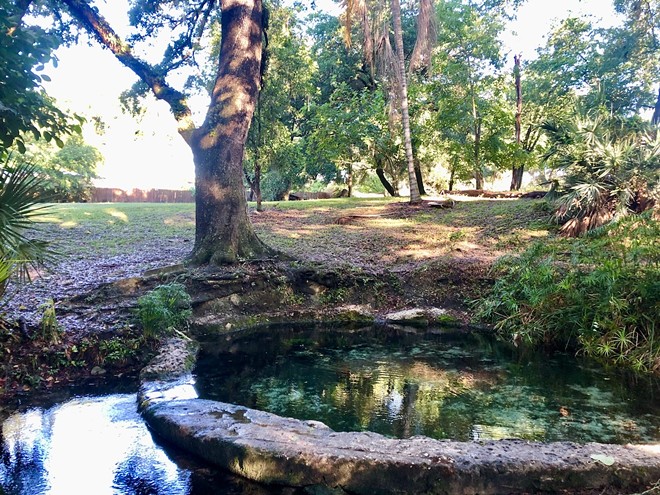
What a miraculous effect, I think, if such healing and restoration could be provided for the many dozens of "lost" springs along the estuary...
My thoughts are interrupted by a cloud of mumbled curse words emanating from the brush on the far side of the pool. I spot a young man, his thin frame folded into a seated position atop a foam sleeping pad, a small knapsack tucked beside him. He stares down toward the spring, and grumbles loudly and continuously—not, as I first suspected, into a cell phone, but to someone or something I can't discern.
Startled, and resisting some pretty serious "stranger-danger" indoctrination I received in the third grade, I manage to say, "Hello there. Are we disturbing you?"
"No," he says, looking up, voice softening. "You are not."
But I sense that we are. His attention seems to hover around the peaceful pool almost like a guardian spirit ... and here we are, noisily splashing in the stream and gobbling picnic snacks. I recall Remer telling me that the spring had a reputation among some city workers as "that place where homeless people go to bathe"—to the point that many felt just fencing it off would be the best solution.
Feeling the need to explain, I say, "This is a beautiful place. I wanted to show it to my son."
"It is the most beautiful place," he agrees. Slowly, he rises to his feet and walks with measured, heron-like steps down the path that leads to the pool. He dips an empty Dasani bottle into the water, slowly fills it, and brings it to his lips.
Now it's my stomach, not my heart, that is in my throat. Everything I've ever been taught about germs, contamination, and outdoor survival turns backflips inside me. "WOAH. Is it OK to drink this water?!" I blurt out.
He fixes me with a stare. My question hangs in my ears.
Now I remember something else Commissioner Smith said. "If you travel to other countries where you can't drink the water, it really comes home to you, how extraordinary it is to have access to water that you can trust is safe and clean." She paused. "For all of us to be running that water through our sprinklers...it's a mark of the height of privilege."
I've almost never had to wonder if it was OK to drink the water in front of me. But many people do—including, evidently, the man across the pool. As well as an estimated 63 million Americans, particularly in small, poor, and minority communities, who are facing the prospect of imperiled drinking water due to industrial dumping, agricultural pollution, or deteriorating water infrastructure.
"Of course it's OK," says the young man after a beat. "This water comes straight from the Earth."
Restoration can be, as Remer says, a surprisingly thorny problem. It's not just about restoring ecological connections, as critical as they are, but also about managing human connections—the widely varying and sometimes conflicting points of desire and need that anchor and attract different populations to a landscape. I want my son to grow up loving and defending the best gift God ever gave Florida—its water. But I also need to recognize that my way is not the only-and-best way of receiving that precious gift. This, I believe, is the challenging process at the heart of what Remer calls "diversifying access" to public greenspaces.
After a few more minutes of playing in the stream and the requisite documentary picture-taking, I suggest to the kiddo that we go find some ice cream. I wave goodbye to the man, still perched above the edge of the spring. I want to return some of the quiet we stole from this place. I follow the trail back to the car, hoping we'll all be able to find what we're looking for.
As we pull back out onto busy Florida Avenue, I glance up at the review. My son is watching the landscape, deep in thought. "What did you think of Purity Springs?" I ask him.
"Mom, it was the most beautiful place."

